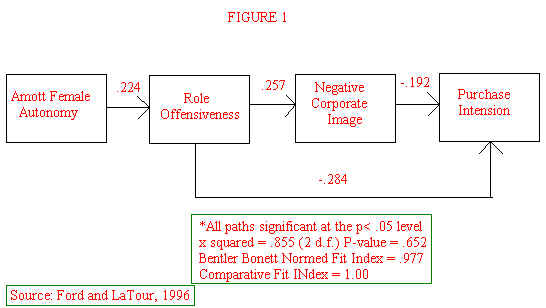![]()
Perceptions of Female Sex Role Portrayals in Advertising:

A Synthesis of Research for Managerial Application in the Pacific Rim
by Michael S. LaTour
Dr. LaTour (MLATOUR@cob-1.business.auburn.edu) is a Associate Professor in the Department of Marketing and Transportation, College of Business, Auburn University.
Introduction
Marketing managers world-wide are becoming aware of the volatility and difficulties in dealing with perceptions of sex-role portrayals in advertising in a global marketplace [Lysonski and Pollay1990, Ford, LaTour, Honeycutt and Joseph, 1994]. At the crux of this managerial dilemma is to what degree should strategists standardize versus localize advertising campaigns as a function of a particular cultures "feminist consciousness" [James and Hill 1991; Ford, LaTour, Honeycutt and Joseph, 1994]. This is a crucial challenge for advertising strategy as more and more managers feel the need to further expand their distribution efforts to additional nations and cultures. Practical guidelines are needed that allow for all of the "theory testing" on this issue to be put into a form that is immediately actionable by strategists working day to day within the robust market opportunities in the Pacific Rim.
In this paper this need will be addressed in two parts: (1) a synthesis of relevant studies that entails both their development in the U.S. and recent empirical extensions of them into the Pacific Rim, and (2) the delineation of specific inferences from this material in the form of "actionable recommendations" that are supported by the previous synthesis.
Empirical Studies
U.S. Studies of Female Role Portrayals in Advertising
Generally, the significant number of U.S. studies on this topic can be broken down into two general areas: content analyses that categorize ads and response studies that assess individuals’ perceptions of ads in general. Longitudinal content analyses have indicated that advertisers in the U.S. are showing some "improvement" or "movement towards political correctness" (PC). For example, Ferguson, Kreshal and Tinkham's [1990] study of ads shown in a 15 year period (1973-1987) in Ms. Magazine showed a decreasing trend in the number of women portrayed as "decorative adornments" for men. Mays and Brady's [1991] study of several general readership magazines in the years 1955, 1965, 1975 and 1985 also showed some "improvement" trends with less depictions (over time) of women as "homebodies". Finally, Klassen, Jasper and Schwartz's [1993] examination of female depictions in Playboy, Ms., and Newsweek from 1972 to 1989 also corroborate these other studies with clear indications that women's roles have been "modernized".
However, while these U.S. longitudinal content analyses studies show more portrayals of women in recent years in "non-traditional" roles, there is still a strong concern by critics that women are treated as "sex objects", demeaned and generally "overshadowed" by their male counterparts in advertising portrayals of the genders [Ford and LaTour, 1996]. This is due in no small part to the fact that feminist philosophies are spreading though out the U.S. population, in particular for those exposed to universities’ "Women's Studies" programs [See Ford, LaTour and Middleton, 1996].
Although there have been several earlier response studies of female role portrayals [See Ford, LaTour and Lundstrom, 1991.], two recent studies have achieved a "high profile". The first of these is a comparative response study conducted by Ford and LaTour [1993]. In it we examined differing perceptions of female role portrayals on the part of women who belong to the National Organization for Women (NOW), the League of Women Voters, and a random sample of non-members from the same geographical region in the U.S. (southeastern Virginia). In this 1993 study, Ford and I, using scales developed in past research [See e.g. Ford, LaTour and Lundstrom, 1991.] found that members of NOW scored highest in their negative view of female role portrayals, (e.g. mean scores on scale items indicating that women are portrayed in demeaning roles and as sex objects). The other two samples showed significantly lower mean scores on such scale items and, therefore, indicating they were significantly less concerned than members of NOW. These findings would naturally be of grave concern to advertisers because NOW has a history of organizing product boycotts against firms that in their view mis-portray women.

A subsequent study by Ford and LaTour (1996) took these issues a step further. In it we found key structural linkages between these perceptions in a census tract based random sample of women from Hampton Roads, Virginia. Specifically, it was discovered that women's self-declared "autonomy" from traditional male values directly impacted on their general perceptions that female role portrayals are offensive (See Figure 1.). This, in turn, affected the degree to which they felt that companies who sponsor offensive ads would discriminate against women (labeled as "Negative Corporate Image"). Both of these factors: "Role Offensiveness" and "Negative Corporate Image," were found to increase these individuals’ felt likelihood that they would boycott products produced by the "offending firm". This exemplifies what could be a very negative chain of events for a firm that unknowingly produces ads perceived to be offensive, especially in the case of more militant, feminist women. While the results of these U.S. studies form a useful empirical precedent, recently attempts have been made to extend this research into the cross-cultural context of the Pacific Rim.
Extension of Research into the Pacific Rim
Backed up by a solid stream of related research [See cf. Henthorne, LaTour and Hudson 1996.],two response studies have tested the highly applicable theory of a "Cross-Cultural Continuum of Sex-Role Development" and resulting sensitivity (or lack thereof) to female role portrayals in advertising [Ford, LaTour, Honeycutt and Voli, 1994; and Ford, LaTour, Honeycutt and Joseph, 1994]. The first study [Ford, LaTour, Honeycutt and Voli, 1994] examines samples of business students from the U.S., Japan, Thailand and New Zealand. We chose to compare views of students because they represent the "vanguard" of their respective societies' values and social views. The second study [Ford, LaTour, Honeycutt and Joseph, 1994] extended this research into the general populations of the U.S., New Zealand and Thailand.
In both studies, the most sensitive female respondents were those from New Zealand, followed by their counterparts from the U.S., followed (in the case of students) by Japan and Thailand. The sensitivity of the New Zealand women is in conformity with previous studies [See the discussion in Ford, LaTour, Honeycutt and Joseph, 1994.] that have made a case that the "spread" of feminism in New Zealand has been quite rapid; in fact, more so than in the more diverse society of the U.S. Naturally, Japan and Thailand reflect more conservative, male-dominated societies. However, there is some evidence [See Ford, LaTour, Honeycutt and Voli, 1994.] that a "fledgling" women's movement in Japan is starting to "flex its muscles." Indicative of this is the recent controversy over billboard portrayals of women in the Tokyo subway system. Thailand on the other hand, still displays evidence of a very conservative nature and a virtual absence of "feminist consciousness" among Thai women.
An even more recent study by Ford, LaTour and Honeycutt [1996] supports that the types of linkages found in the U.S. study by Ford and LaTour [1996] (See Figure 1.) are quite strong in a New Zealand sample, while relatively weak in a Thai sample. That is, the linkages are most profound for New Zealand women, especially those with strong "female autonomy from a perceived male dominated society," not only as to a negative view of the way women are portrayed , but also in terms of a negative corporate image of offending firms and a resulting intention to boycott them. On the other hand, the linkages between these factors for Thai women are weak at best, given their low to relatively "non-existent" feminist orientation. However, according to a panel of Thai academicians polled as part of this recent study, the lack of feminist consciousness in Thailand leaves open the possibility of offending men and, to some extent, women if female models are shown in ads in non-traditional roles (e.g. doing a "man's job").
So, What Does All This Mean to Managers in the Pacific Rim?
Several key recommendations for managers can be culled from this evaluation of academic research. Generally speaking, one can infer that it "pays to localize" advertising campaigns for women. In other words, the promotional strategy will often need to vary by the country/market of focus. Specific recommendations are as follows:
Conclusion
Clearly, it behooves managers engaged in advertising strategy in the Pacific Rim to be "culturally sensitive" when it comes to the portrayal of women in advertising. Obviously, it costs a lot more money to "localize" an advertising campaign for each country than to "standardize" the approach for the entire set of markets being considered. However, in light of the evidence revealed by the studies referred to in this paper, it appears that the worst mistake a manager can make is to naively assume he can standardize their campaign targeted to women across diverse cultures.
However, more applied research remains to be done. As new markets, such as China, are further developed, additional assessment and challenges to management strategists are necessary to avoid cultural-based blunders. Yet, the potential of such large markets as those of the Pacific Rim is awe inspiring, and it stands to reason that, as the Pacific Rim is further developed by multinational-oriented firms, those managers with insight into these issues will hold a strategic edge.
In this study, I have endeavored to provide applications from a stream of research on perceptions of female role portrayals. Given the dynamic nature of markets and societies, managers’ attention to these phenomena should be on-going. Whether one agrees with feminist philosophy or not, sensitivity to female role portrayals is a component of advertising environmental reality in the dynamic markets of the Pacific Rim.
References
Ferguson, Jill Hicks, Peggy J. Kreshal and Spencer Tinkham " In the Pages of Ms.:Sex Role Portrayals of Women in Advertising," Journal of Advertising Vol. 19, No. 1, 1990; 40-51.
Ford, John B., and Michael S. LaTour "Differing Reactions to Female Role Portrayals in Advertising" Journal of Advertising Research Vol. 33, No. 5, September/October 1993; 43-52.
Ford, John B., and Michael S. LaTour "Contemporary Female Perspectives of Female Role Portrayals in Advertising" Journal of Current Issues and Research in Advertising Vol. 18, No. 1, Spring 1996; 81-95 .
Ford, John, B., Michael S. LaTour and Earl Honeycutt "A Multi-Cultural Examination of Adult Women and their Perception of Sex Role Portrayals in Advertising" Working paper, Old Dominion University 1996.
Ford, John B., LaTour, Michael S. and Lundstrom, William J. "Contemporary Women's Evaluation of Female Role Portrayals in Advertising." Journal of Consumer Marketing Vol. 8, No. 1, 1991; 15-28.
Ford, John B., Michael S. LaTour, and Courtney Middleton "Womens Studies and Advertising Role Portrayal Sensitivity" Working Paper, Old Dominion University 1996
Ford, John B., Michael S. LaTour, Earl D. Honeycutt and Matthew Joseph "Female Role Portrayals in International Advertising: Should Advertisers Standardize in the Pacific Rim?" American Business Review Vol. 12, No. 2, May 1994; 1-9
Ford, John B., Michael S. LaTour, Earl D. Honeycutt, and Patricia Voli "Perceptions of Sex Role Portrayals in Advertising: A Comparison of Business Students in the United States, Japan, Thailand and New Zealand" Asian Journal of Marketing Vol 3, December 1994; 21-36.
Henthorne, Tony L., Michael S. LaTour, and Tim Hudson, "Japanese Couples' Marital Roles in Stages of Product Purchase Decision Making" International Marketing Review (forthcoming).
James, William L., and John S. Hill "International Advertising Messages: to Adapt or Not to Adapt (That is the Question)" Journal of Advertising Research Vol. 31, No. 4, 1991; 65-71.
Klassen, Michael L., Cynthia Jasper and Anne Schwartz "Men and Women: Images of Their Relationships in Magazine Advertisements" Journal of Advertising Research Vol. 33, No. 2, 1993; 30-39.
Lyonski, Steven, and Richard W. Pollay "Advertising Sexism is Forgiven But Not Forgotten: Historical, Cross-Cultural and Individual Differences in Criticism and Purchase Boycott Intentions" International Journal of Advertising Vol. 9, 1990; 317-329.
Mays, Amy E. and Brady, Donald L. "Women's Changing Role Portrayals in
Magazine Advertisements: 1955 to 1985." working paper, Millersville State
University Series 1990. ![]()